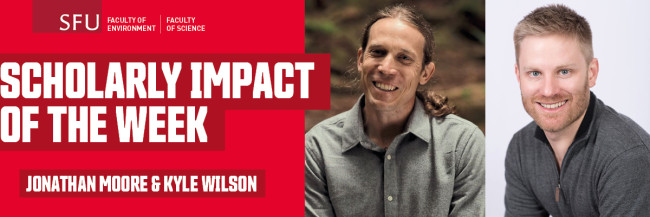
Over the past several decades, significant human-caused pressures have threatened Pacific salmon populations. Salmon may encounter many different stressors in both their freshwater and ocean environments. Logging, for example, could put spawning rivers at risk. Fluctuating ocean climate and competition from hatchery fish could decrease ocean survival.
Simon Fraser University (SFU) Professor Jonathan Moore and Salmon Watersheds Lab researcher Kyle Wilson embarked on a study that reviewed over forty years of cascading shifts in salmon and trout populations, referred to as “regime changes.”
Moore holds a joint appointment between SFU’s School of Resource and Environmental Management and Department of Biological Sciences, and Wilson is a former SFU and Banting Postdoctoral Fellow and the Applied Quantitative Biologist at Central Coast Indigenous Resource Alliance.
Wilson led the study, supervised by Moore, to analyze over 40 years of counts in Vancouver Island’s Keogh River for five species of salmonids: Steelhead, Coho Salmon, Pink Salmon, Dolly Varden and Coastal Cutthroat Trout. SFU PhD candidate (now alumni) Colin Bailey and provincial collaborator Trevor Davies also contributed to the study.
Their paper, Marine and freshwater regime changes impact a community of migratory Pacific salmonids in decline, offers new understanding of how B.C.’s wild salmon may be changing and why.
We spoke with Moore and Wilson about their research findings.
What makes the Keogh River (Giyuxw to local Kwakiutl First Nations) such an important and distinctive habitat to study?
This river is a small watershed in northeast Vancouver Island. It is a beautiful place, where tea-coloured water flows through mossy forests, and where both people and bears eagerly await salmon to return to their natal waters. From a scientific perspective, one of the remarkable things about the place is that it has been extensively studied for so long. It is truly a hub for learning about how salmon rivers work and how they are changing. More information about the watershed can be found at keoghriver.net.
The study drew on 40 years of records on salmon returns to the Keogh River. What other data did you use?
The importance of on-going monitoring of salmon and trout can’t be overstated. It is hard to count fish, particularly for species like salmon that migrate long-distances between the ocean and their natal rivers. Year after year, many different people put in a ton of work and expertise into documenting the shifting state of these fish populations. For this study, we analyzed these long-term data collections and also brought in information on how the ocean and watershed environments are changing, particularly with respect to climate changes.
Can you describe your findings? What significant regime changes are affecting salmon populations?
Our study documented how salmon and trout populations are changing across four decades. Some fish, namely Coho Salmon and Pink Salmon, did not exhibit pronounced systematic changes. However, species that spend much of their lives in freshwater—Dolly Varden, Cutthroat Trout, and Steelhead—all declined dramatically in productivity over the last decade or so. In Steelhead, their declines were driven equally by the freshwater and ocean phases of their life cycle. Patterns of change were associated with both watershed changes, such as logging, as well as factors in the ocean, including how many competitors and predators there are. Together, these freshwater and ocean changes are shifting the ability of salmon and trout to thrive.
What types of conservation and scientific efforts are needed to help Pacific Coast salmon populations recover?
This study and many others continue to reveal that climate change and cumulative effects are posing real risks to salmon. There is an urgent need for global action on climate change, but also a need for action to help address the many local watershed stressors that challenge salmon. I lead an initiative called the Watershed Futures Initiative, where we advance the understanding and governance of climate change and its cumulative effects in salmon watersheds. Many people and organizations are working on this grand challenge to design conservation and restoration actions to benefit their local waters.
Alongside these conservation efforts, there remains a key need to continue investing into monitoring salmon populations and the syntheses of these data. In order to design evidence-based management and conservation actions, we need consistent and accurate monitoring of the state of salmon and their watersheds.
SFU's Scholarly Impact of the Week series does not reflect the opinions or viewpoints of the university, but those of the scholars. The timing of articles in the series is chosen weeks or months in advance, based on a published set of criteria. Any correspondence with university or world events at the time of publication is purely coincidental.
For more information, please see SFU's Code of Faculty Ethics and Responsibilities and the statement on academic freedom.